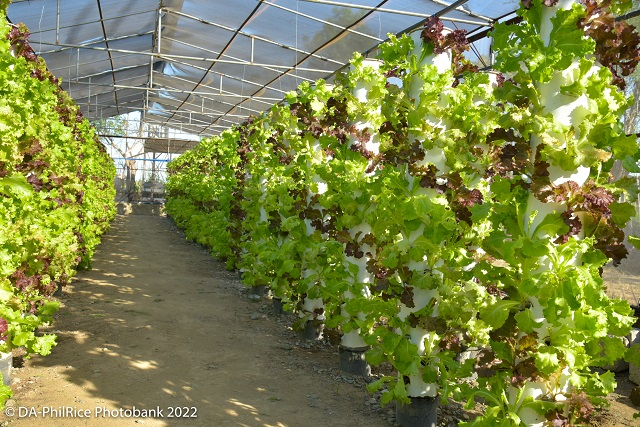
Adding a vertical garden in a rice-based farming system augments sources of income; an established setup in thePalayamanan farm of the Department of Agriculture-Philippine Rice Research Institute (DA-PhilRice) showed.
Dr. Marissa V. Romero, lead of PhilRice’s project Modernized rice-based farming systems and value-adding technologies, said that integrating vertical garden in Palayamanan increases sources of food and income and enhances resiliency. Palayamanan integrates diverse crops and livestock in a farm to increase produce and income.
Engr. Kristine S. Pascual, activity lead, detailed that they harvested an average of 1kg of lettuce from each growing tower 25 days after transplanting.
“This is 10 times higher than the usual harvest from the same area,” Pascual said.
At P200 to P300 per kg gate price of lettuce, she said that P20,000 to P30,000 can be generated from 100 towers in one cycle.
The vertical garden at DA-PhilRice’s Palayamanan farm was established in a 100-m2 greenhouse where vegetables were grown following the hydroponics and aeroponics systems.
“This is the system suited for farmers with limited space for vegetables,” Pascual said.
Hydroponics and aeroponics are production methods where plants are grown in a nutrient solution rather than in soil. Hydroponics uses a medium for growing the plants while aeroponics is in an air or mist environment.
Pascual shares that they used cocopeat as material to plant vegetables for the hydroponics system. This is being enriched with nutrients during fertigation in which the fertilizer is incorporated within the irrigation water.
“For the aeroponics setup, plant roots are suspended in the air, but we used a polyfiber to hold them,” Pascual explained.
In collaboration with the Central Luzon State University (CLSU) College of Engineering, 100 units of growing towers made of white polyvinyl chloride pipes were installed. The towers have 6-in diameter and 1.5-m height. They are connected to a series of buried pipes that serve as drainage system of the nutrient-enriched recirculating water during irrigation, and act as the ground heat exchanger system.
“We hope to replicate more vertical tower gardens in DA-PhilRice branch stations to showcase this technology and promote it to the Rice Business Innovations System (RiceBIS) communities and other interested groups/individuals,” Dr. Romero said. RiceBIS is a flagship program of the Institute that aims to develop a model of community transformation in rice farming communities.
A harvest festival attended by DA-PhilRice staff was recently held in collaboration with Pilipinas Kaneko Seeds Corporation and CLSU as part of their demonstration trial of lettuce varieties using the system.




